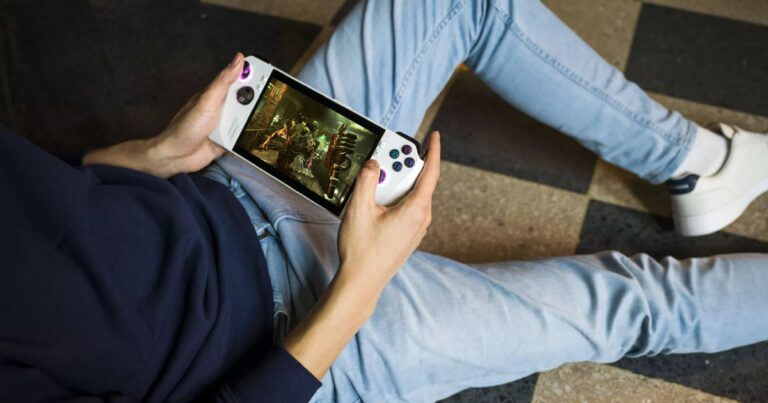We give the latest handheld PC, ASUS’ ROG Ally, a spin, then check out NBA 2K24, Samba de Amigo: Party Central and more.
Ever since the launch of the Steam Deck, the handheld PC market has gone absolutely bonkers. From AYANEO to the upcoming Lenovo Legion Go, there’s no shortage of competition, but ASUS is hoping to win you over with its shiny new competitor the ROG Ally.
It’s not difficult to see how the company might get its wish, because the Ally is a pretty sleek bit of kit. With a clean white and black colour palate and relatively slim formfactor, it’s a well-designed unit, especially once you add on some RGB lighting around the sticks for good measure. More importantly though, it’s much comfier in the hand than something like the Steam Deck, with a bit less bulk, offset sticks and well-placed face buttons.
No there aren’t any Steam Deck-like touchpads, but aside from that noticeable exclusion it’s pretty feature rich in terms of functionality – jamming in shoulder buttons, a 3.5 mm headphone jack, micro SD slot, a finger print sensor and four smaller function buttons.
I also appreciated the inclusion of the extra triggers on the back that are particularly handy should you want to customise certain games (like mapping a dodge roll in Elden Ring) and the placement of air vents away from the hands which do well to avoid anything from becoming too toasty.
They’re all conscious design decisions to help make the ASUS ROG Ally an incredibly capable powerhouse handheld, and thanks to the device running Windows 11, you’ll be able to pick and choose titles from a whole range of gaming services including the likes of Xbox Game Pass, Steam, Epic Games Store and more.
It’s all linked together through Armory Crate, the Ally’s internal command centre and game launcher. Similar to AYANEO’s AYASpace, once you download a game, Armory Crate grabs it and places it within its own internal library alongside competing services for an easier means of access. Select the game and Armory Crate will then launch the appropriate service and get you right into the action. It’s simple, pretty seamless and a lot more polished than our experience with AYASpace.
Love Gaming?
Get the latest Gaming news, features, updates and giveaways straight to your inbox Learn more
Once you’ve booted up your game, mileage will naturally vary depending on how high you set your power wattage and the grunt the game requires. Booting up Batman Arkham Asylum, for instance, was buttery smooth at maximum settings, as were indie titles like Ghost Song. Forza Horizon 5, meanwhile also performed admirably at low graphical settings to retain a consistent frame rate, while unfortunately Redfall did have the occasional chug.
No matter what you decide to play, the 7” 1080p screen is also incredibly vibrant and manages to really pop when you have some colour to show off. A bit of time with Tinykin was the perfect example, which was positively beatify and helped accentuate the game’s Saturday morning cartoon vibes. You can reduce the resolution for 720p to gain a bit of a performance boost, but whether or not that trade-off is worth it will likely come down to personal choice.
With so many things working in the ROG Ally’s favour, the biggest negative is usurpingly its battery. While the device is indeed capable of keeping up with many recent hits, it chews through power to do so. As a result, don’t be surprised to need to whack on a charger in as quickly as 1 hour, especially if you’re planning to boot up recent titles like Starfield or Metal Hellsinger. If you’re planning on playing the ROG Ally close to a power source, that might not be an issue, but given the $1299 asking price it’s certainly worth considering all the same.
With the ROG Ally, ASUS has delivered my favourite handheld PC thus far. It’s not perfect, but is a powerful, comfortable unit that’s worth your attention if you have the funds to jump aboard.
The ASUS ROG Ally is currently available from JB Hi-Fi.
Also out now…
NBA 2K24 (PS5, Xbox Series X/S, PS4, XBO, PC)
It may sound like a broken record, but NBA 2K 24 continues to be one of the most polished sports titles around, and will likely prove to be a big hit with big-time ballers. Its presentation is spectacular, as is its commentary track.
The development team’s dedication to replicating the look and feel of the sport in its entirety is clearly evident, right up to the various antics that are included throughout each quarter like cheerleader performances. Their inclusion has to be commended, but unfortunately once the novelty wears off you’ll likely skip through all the antics to continue the flow of the game all the same.
I particularly enjoyed my time with Mamba Moments (a focus on some of the late great Kobe Bryant’s most iconic games). Much like the Jordan mode last year, Mamba Moments is perfect for re-experiencing Bryant’s legacy in a whole new way and felt like a particularly special tribute, although hardcore fans be disappointed that it skips past some of the star’s origins.
And yet, while there’s a lot to love about NBA 2K24, those pesky microtransactions are still very much prominent and continue to worm their way into many of the game’s modes. It’s perhaps no more egregious than previous years but it’s a shame that it mars an otherwise enjoyable entry in the franchise.
Fae Farm (Switch)
Farm-life games feel like they’re a dime a dozen on the Switch nowadays, but that shouldn’t stop you from enjoying the inherent charm that Fae Farm offers.
Taking more than its fair share of cues from the likes of games like Stardew Valley, Fae Farm is hardly short on activities. Whether you’re mining, fighting enemies, growing crops, exploring or fishing, you’ll be absolutely flat chat. Overall, it’s an enjoyable loop, but in the early stages can feel a tad overwhelming as you work to juggle all your responsibilities at the same time.
Once you do get a grip on the many mechanics, it’s easy to appreciate Fae Farm’s low-stakes, cosy vibe that I was all about, even when running about in dungeons looking to put an end to nasties like whirlpools or poison. Neat twists like some home décor items helping buff key character stats like health and stamina only give the game a bit more personality, but if you’re not a real fan of the genre, it likely won’t do a good job at converting you.
As a result Fae Farm feels like a solid new life/farm sim entry that should do well to keep genre fans entertained for many, many hours.
Samba de Amigo: Party Central (Switch)
SEGA’s Samba de Amigo series may have taken something of an extended rest over the last two decades, but the maracas are back in action with Party Central. Well, kind of. Lovers of plastic peripherals will be disappointed with the lack of pack-in maracas for this latest dance party, but I found the Switch’s joy-cons to be a perfectly adequate substitute.
Unsurprisingly much of the series’ core rhythm-centric formula remains untouched, meaning you must once again wiggle and waggle your controllers to high, middle and low heights in time with whatever song is playing on screen. That’s in addition to the Just Dance-like pose moves that will see you contorting into all sorts of positions.
Party Central hardly reinvents the wheel but the curated track list does well to keep the energy in high gear, from Carly Rae Jepsen to Pitbull to a Ricky Martin Classic. Even some Sonic songs get a bit of love, which means you’ll get the blood pumping (and even a little sweaty) solo or with a group of friends.
I did have a few annoyances with Joy-Cons either not registering my moves or occasionally being too sensitive, but outside of that this is a whacky and wild wonder worth revisiting.
Ghost Song (PS5, Xbox Series X/S, Switch, PS4, XBO, PC)
If you’re looking for a Metroidvania that really pushes you to your limits than you should take a pretty serious look at Ghost Song. That’s because this futuristic feast doesn’t hold its punches and presents an incredibly challenging adventure that takes more than a few cues from Soulsborne-style titles. Die in this beautifully realised but eerily desolate world and you’ll lose all your hard-earned currency – the only way to reclaim it being a perilous trek back to your last location.
But while you’ve heard a lot of this before, Ghost Song does shake things up with its combat. Firing too quickly from your cannon, for example, may slow down the weapon’s firing rate due to overheating, but that allows you to instead use that cannon arm to swipe at enemies for extra damage while the ammo recharges. It adds a fun layer of strategy to battles as you constantly swap between attack types, but does also add a further layer of complexity.
Ghost Song is not an easy game, but if you’ve got time, dedication and patience, you can get a fair bit out of it.
For more on this topic, follow the Gaming Observer.


































